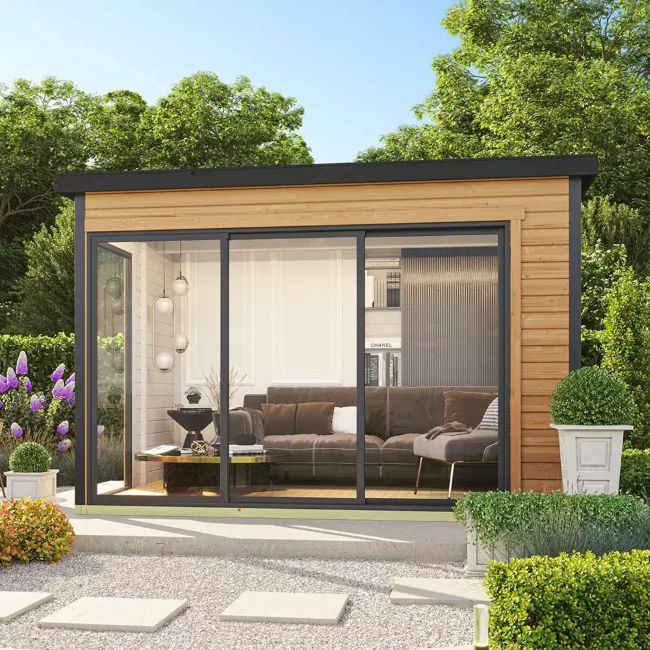The Ultimate Garden Room Guide

Adding a garden room is one of the best ways to create extra space without the hassle of a full home extension. Bespoke garden rooms offer customization options that allow you to tailor the room to meet your specific needs, such as dimensions and materials, enhancing both functionality and aesthetic appeal. Whether you opt for prefabricated models or decide to build a garden room from scratch, selecting trusted retailers or bespoke services is crucial to ensure quality and safety. Whether you want a stylish home office, a relaxing garden retreat, or even a home gym, this guide will walk you through everything you need to know — from choosing the right size to understanding how they are built. If you’re thinking of adding one to your garden, check the guys from Apex Garden Rooms (Scotland).
Introduction to Garden Rooms
A garden room is a stylish and versatile outdoor living space that enhances both your home and garden. Unlike traditional conservatories or garden sheds, garden rooms are designed with modern, high-quality materials that ensure they are fully insulated and suitable for year-round use. Whether you need a home office, a gym, an art studio, or a relaxing retreat, a garden room offers a seamless extension of your living space without the hassle of a full home extension. By integrating a garden room into your property, you not only increase its value but also create a unique space that blends the comfort of indoor living with the beauty of your garden.
What is a Garden Room?
A garden room is a self-contained building installed in your outdoor space, designed to provide a comfortable and practical extension of your home. Unlike sheds or summerhouses, garden rooms are fully insulated, properly wired for electricity, and built to be used all year round, no matter the weather.
The significance of wall thickness in a garden house cannot be overstated; thicker walls provide enhanced stability, safety, and longevity, making them superior choices for durability and resistance to weather elements.
They can serve a wide range of purposes — from quiet workspaces to cosy lounges — and because they are often considered “permitted development,” many garden rooms don’t require planning permission in the United Kingdom. However, it’s always worth checking specific local regulations if you have any doubts.
Benefits of Garden Rooms
Garden rooms offer a multitude of benefits that make them an attractive addition to any home. One of the primary advantages is the extra living space they provide, which can be used for a variety of purposes. Whether you need a quiet home office, a serene yoga studio, or a dedicated workshop, a garden room offers a peaceful retreat from the main house. These rooms can be designed to harmonize with your garden and home, creating a seamless transition between indoor and outdoor spaces. Additionally, garden rooms are a cost-effective way to add space to your home, with prices ranging from £2,000 to £30,000 or more, depending on the size, materials, and features. This flexibility makes garden rooms a practical and appealing solution for homeowners looking to expand their living space.
Garden Room Sizes
Garden room sizes can vary greatly depending on the size garden room you need and how you plan to use the room. A garden room can provide additional space at home, making it a versatile addition to your property.
It’s important to evaluate the size to ensure it complements a small garden without overwhelming it.
For small gardens or simple uses like a compact office or hobby space, garden rooms around 2m x 2m can be ideal. These sizes are compact enough to fit into most outdoor spaces while still providing enough room for a desk, chair, and storage.
If you need a bit more space for activities like yoga, workouts, or entertaining guests, a medium-sized garden room around 3m x 4m is a popular choice. This offers plenty of flexibility without overpowering the garden itself.
For larger projects, such as garden studios, multi-purpose spaces, or guest accommodation, you might want to consider a large garden room measuring 5m x 5m or more. Larger rooms can be split into zones, giving you a full office and lounge area within one beautifully designed building.
Many companies offer fully bespoke sizing too, allowing you to create a garden room that perfectly matches your outdoor space and needs.
Garden Room Construction Details
The construction of a garden room is more advanced than you might expect — and this is a key reason they offer such good value compared to traditional home extensions. The build process is efficient and can be quicker than constructing other structures like conservatories, offering both DIY and professional options to suit different needs.
Typically, a quality garden room starts with a solid foundation, often using concrete pads, ground screws, or a full concrete slab. This ensures the building remains level, stable, and weatherproof over time.
The main structure usually features a robust timber frame, often using treated timber to resist rot and pests. Insulation is fitted into the floor, walls, and ceiling to create a comfortable indoor environment throughout the seasons, keeping heat in during winter and providing a cooler space in the summer months.
High-quality doors and windows are essential, with features like premium double glazing for thermal efficiency and toughened glass for security. Strategic placement of these elements optimizes views and natural light, enhancing the overall design and functionality of the space.
For the exterior, popular cladding choices include western red cedar, Siberian larch, or modern composite materials, all offering a sleek, natural look with minimal maintenance. Most garden rooms are finished with EPDM rubber roofs or other high-quality flat roofing materials to ensure longevity and weather resistance.
Inside, expect plastered and painted walls, proper flooring, full electrical installation (including lighting, power sockets, and sometimes heating or cooling systems), and often broadband or Wi-Fi connectivity.
Garden Room Cost and Budgeting
The cost of a garden room can vary widely based on several factors, including size, materials, and additional features. Modular garden rooms are generally more cost-effective, with prices starting around £2,000. However, for larger and more complex designs, the cost can rise to £30,000 or more. When budgeting for your garden room project, it’s important to consider the cost of essential features like double glazing, insulation, and underfloor heating, which can enhance the comfort and usability of the space. Additionally, factor in the costs of materials, labor, and any necessary permits or inspections. By carefully planning your budget, you can ensure that your garden room project stays on track and meets your needs without unexpected expenses.
Design and Planning
Designing and planning your garden room requires thoughtful consideration of several key factors. Start by determining the size and shape of the room, ensuring it fits well within your garden and meets your intended use. Choose materials and features that complement your home and garden, and consider practical aspects like natural light, ventilation, and insulation. Depending on the size and location of your garden room, you may need to obtain planning permission. Working with a professional designer or architect can help you navigate these considerations and create the perfect garden room that aligns with your needs and budget. Detailed plans and careful planning will save time and ensure a smooth construction process.
Insulation and Heating
Insulation and heating are crucial for making your garden room comfortable and usable year-round. A well-insulated garden room reduces heat loss, keeping the space warm in winter and cool in summer. Underfloor heating is a popular choice for garden rooms, providing efficient and even heat distribution. Additionally, double glazing and high-quality insulation materials can further enhance the thermal efficiency of the room. When selecting insulation and heating options, consider factors like energy efficiency, cost, and maintenance requirements. A properly insulated and heated garden room not only provides a cozy space for relaxation and entertainment but also adds value to your property by ensuring it can be enjoyed in all seasons.
Traditional Garden Rooms
Traditional garden rooms focus on classic designs and craftsmanship, making them a perfect choice for homeowners who want their new garden building to blend seamlessly with older properties or period homes. In contrast, contemporary garden rooms emphasize modern design aspects, such as innovative materials, shapes, and integration with the surrounding garden.
These designs typically feature natural timber cladding, such as oak or painted timber, along with pitched or tiled roofs that mimic the look of a cottage or historic outbuilding. Traditional garden rooms often include larger windows with Georgian-style frames or even French doors, creating a charming and elegant look that feels timeless. Enlisting a professional designer for the finishing touches can elevate the overall appearance and functionality of the space.
Inside, these rooms can be just as comfortable and modern as contemporary designs but offer a more rustic and homely feel, ideal for country gardens and heritage homes.
Quality Garden Offices
With remote working now more common than ever, quality garden offices have become one of the most popular types of garden rooms in the United Kingdom. Involving family members in the decision-making process when selecting a garden room can enhance the enjoyment of the space and cater to diverse needs, making it a focal point for family leisure activities and a way to create cherished memories together.
A professionally built garden office includes everything you need for a productive, professional environment. This usually means full insulation, heating options (such as electric radiators or underfloor heating), plenty of natural light from well-placed windows, and high-quality security features like strong doors and locking systems.
The best garden offices also consider connectivity needs, offering built-in options for broadband and smart home features. You can even choose to add features like soundproofing, making it easier to hold video calls or focus without distractions.
Compared to renting office space, a garden office can pay for itself within a few years, providing an unbeatable work-life balance and boosting your property value at the same time. Additionally, garden rooms can save you money on commuting and gym memberships, offering long-term value and cost-effectiveness.
Types of Garden Structures
If a full garden room doesn’t quite suit your needs, there are plenty of other garden structures to consider:
- Pergolas: These open structures create a defined seating area with partial shelter, perfect for outdoor dining or growing climbing plants.
- Summerhouses: More basic than garden rooms, summerhouses are best for occasional use in warmer months, offering a charming spot to relax.
- Garden pods: Compact, modern, and often pre-fabricated, garden pods are ideal for solo use — such as a one-person office or reading nook.
- Gazebos: Freestanding, open-sided shelters offering protection from the sun and rain, perfect for garden parties and social gatherings.
When comparing cheap garden rooms to bespoke options, it’s important to consider that cheaper models often feature thinner walls, which can affect stability and longevity. The cost of garden rooms varies significantly depending on factors like wall thickness, so potential buyers should weigh the trade-offs to ensure they select a structure that meets their needs for quality and durability.
Each of these structures has its own benefits and suits different budgets, purposes, and garden styles. However, for year-round use, nothing beats a properly built, fully insulated garden room. While cheaper options like traditional wooden summer houses can be more affordable, they may not be usable year-round, unlike sturdier garden rooms that offer better quality and longevity.
A garden room is designed for comfort and livability, unlike a garden shed, which is primarily used for storage. Additionally, a garden room is a stand-alone building, serving as an independent structure separate from the main home, and can be used for various purposes like an office, gym, or games room.


